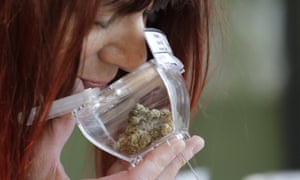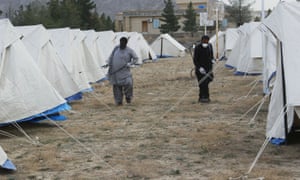Deaths of despair: why America’s medical industry explains working-class suicides
A system based on corporate pursuit of profit sets the US apart from other countries, fleecing the poor to give to the rich
Chris McGreal Thu 19 Mar 2020 THE GUARDIAN

A dorm room for clients recovering from drug addiction is seen at Recovery Point in Huntington, West Virginia. Photograph: Brendan Smialowski/AFP via Getty Images
The US healthcare system is helping to kill people in staggering numbers. And when it isn’t driving Americans to an early grave, the medical industry is bleeding the rest of the country of resources at the expense of decent jobs, crucial infrastructure and schools, according to a new book by two of the country’s leading economists.
As America’s health system faces its greatest challenge of recent times in the coronavirus, Anne Case and Angus Deaton, who won the 2015 Nobel prize for economics, say the pursuit of profit by medical corporations has played a leading role in the surge of “deaths of despair” since the 1990s, led by opioid overdoses, alcoholism and suicide.
Get Society Weekly: our newsletter for public service professionals
Read more
The Princeton economists were the first to reveal the phenomenon which by 2017 was claiming the lives of 158,000 Americans every year – a number they liken to three 737s’ worth of passengers falling out of the sky every day. Case and Deaton, who are married, also discovered that the surge in deaths of despair was overwhelmingly among white working-class Americans without a university degree, and that it was forcing down life expectancy in the US.
Now their new book, Deaths of Despair and the Future of Capitalism, explores why this tragedy is an unusually American phenomenon and concludes that the greed of the US’s medical corporations was both an important driver in creating the conditions for the rise in deaths of despair and in providing the means for many to kill themselves.
There is something going on in America that is different, and that is particularly toxic for the working class
“There is something going on in America that is different, and that is particularly toxic for the working class,” they write.
The book springs from Case and Deaton’s shocking revelations five years ago about the causes of so many Americans dying in middle age and younger, a phenomenon not seen in any other industrialised country. Life expectancy rose sharply in the US through the 20th century but over the past two decades fell by 25% for white Americans without a university degree even as it continued to rise for the better educated and for other races. The geography of this tragedy – people dying younger in West Virginia and Mississippi and living longer in New York and California – reflects the country’s deepening class divide.
]A memorial in Huntington, West Virginia.
The city has been portrayed as the epicenter
of the opioid crisis. Photograph:
Brendan Smialowski/AFP via Getty Images
The couple concluded that the medical industry is at the heart of two key drivers in making those deaths an American phenomenon.
“One fact is that they unleashed these extremely powerful opioids on to the general public as if they were jelly beans at an Easter parade and that has not happened in Europe,” said Case. “The second is the way that we organise our healthcare system. We have the most expensive healthcare in the world and how do we pay for that? We pay for that per person.”
That has created a system Case and Deaton described as “Sheriff of Nottingham redistribution” in the fleecing of the poor to give to rich corporations while the high cost of healthcare forces companies to shed jobs and drives firms to bankruptcy.
“The American healthcare system is a leading example of an institution that, under political protection, redistributes income upwards to hospitals, physicians, device-makers, and pharmaceutical companies while delivering among the worst health outcomes of any rich country,” the economists write.
That in turn has contributed to the retreat of steady, decently paid work in working-class communities at the cost of social cohesion and helped drive the retreat to drugs and alcohol, and an increase in suicides.
“The pillars that held communities together are a job with meaning, a family life that was stable, getting to know and raise your kids, and hope for them for the future,” said Case. “Attachment to traditional churches fell dramatically as well. In the US, organised religion is an incredibly important institution and gave people a place of comfort during difficult times.”
The economists say that while globalisation and technical change, particularly robots, are often blamed for destabilising communities, other industrialised countries facing similar challenges have not experienced a comparable rise in deaths of despair. They conclude that the greed of America’s medical industry played a central role, calling it “a cancer at the heart of the economy” that has resulted in a “uniquely American calamity that is undermining American lives”.
“Unlike the countries of Europe, we have let the healthcare sector just run totally free. Totally, in that it was 5% of GDP in 1960 and it’s 18% of GDP today. It’s eating the economy from the inside out,” said Case.
In other industrialised countries medical treatment is covered at least to some degree by public funds. The structure of US healthcare passes the cost to the individual or their employer through private insurance. As the medical industry has grown more rapacious, so insurance premiums have surged and patients have been required to make ever larger out-of-pocket payments that can amount to thousands of dollars a year.
US drugmakers charge up to 10 times as much for insulin in a country where diabetes is rampant as they do across the border in Canada. For many Americans, the extra hundreds of dollars a month are not covered by insurance.
“The cost of healthcare is like a tribute that Americans have to pay to a foreign power,” the economists write.

The sometimes staggering cost of healthcare means that Americans in need of everyday items such as insulin to treat diabetes resort to the black market. Photograph: Brendan Smialowski/AFP via Getty Images
Case and Deaton said that has taken a toll on employers too over the past two decades and contributed to the decline of working-class communities.
“Firms used to be able to afford to be the providers of social insurance, both healthcare and defined benefit plans for pensions. But we don’t live in that world any more. So that as healthcare becomes more and more expensive, these firms can’t afford to keep on workers that aren’t worth to them what they have to pay for their healthcare,” said Case.
So jobs get outsourced to contract workers who, if they have health insurance through their employers at all, find that it comes with requirements to pay thousands of dollars in out-of-pocket costs before their insurance kicks in. Many low-income families deal with this by not going to the doctor except in an emergency, or taking only take half their prescription pills each day to minimise costs, and so compounding the social crisis as their health fails.
The burden of extortionate medical costs is also felt by state governments forced to divert funds from crucial infrastructure maintenance, education and other public work projects to fund the public Medicaid scheme for very low-income families.
It’s not a free market at all. It’s a giant swamp
The economists attribute this to a failure of capitalism, arguing that healthcare and the free market are incompatible. But Deaton, a Scot who is now also a US citizen, scoffs at the idea that this is the free market at work when medical corporations pour vast amounts of money into buying politicians and laws to protect what he goes so far as to suggest is a corrupt health system.
“It’s not a free market at all. It’s a swamp. It’s a giant swamp that’s killing people in large numbers and making a lot of providers very rich,” said Deaton.
Case hopes their research will “help people connect the dots between what’s happened in the healthcare industry and what’s happening to low-wage workers in America.
“If enough people understood that the reason that these once great state universities have to increase their tuition to the point where in-state kids can’t go any more because the state can’t afford to fund them, because their Medicaid bills are so expensive; or if people understood that the reason that infrastructure is decaying is because the states don’t have the money because they’re paying their Medicaid bills; or if people understood that the reason that they’re being outsourced is because of the cost of healthcare premiums, maybe there might be enough of a push for cost control to actually see real change,” she said.
That may become even more evident if the toll of the coronavirus includes bankrupting medical bills for weeks of treatment for large numbers of Americans. But Deaton does not underestimate the forces arrayed against change.
“This is a system that was designed by an immensely clever team of devils who programmed it in a way that is self-protecting and really difficult to change,” he said.
Deaths of Despair and the Future of Capitalism, Princeton University Press, $29.95 / £25



























